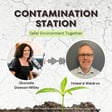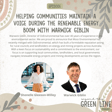
Asbestos, Legacy Landfills, and Council’s Role in Managing Contaminated Land with Malcolm Adrien
Malcolm Adrien is an environmental scientist with 14 years’ experience in the environmental consulting and contaminated land sector. He managed several consultancies in the Newcastle region before he made the switch to local government in 2023 where he took on the newly created role at Maitland City Council as the Senior Contaminated Land Officer.
Malcolm has a strong background in contaminated site assessment, remediation, environmental monitoring and is also an EIANZ CEnvP for Site Contamination & SafeWork NSW Independent Licensed Asbestos Assessor.
In this episode, Malcolm Adrien shares his journey from environmental consulting to his current role in local government.
You will learn about the complexities of managing contaminated land within a local council's jurisdiction, including the challenges of dealing with historic landfills and unexpected contamination in development projects.
Malcolm discusses his work on the Anambah Landfill, offering insights into the remediation strategies being implemented to manage this site. He also touches on the importance of early intervention in contaminated land management and the value of having strong technical expertise within local councils.
For those interested in asbestos management, Malcolm explains the regulatory requirements in New South Wales and shares practical advice for handling asbestos in various scenarios. The episode wraps up with Malcolm's tips for young professionals aiming to build a career in the contaminated land sector.
-----
Are you a local NSW council member looking for more resources like this?
You are invited to join the Local Government NSW Contaminated Land Network!
Local Government NSW (LGNSW) hosts a free, online network for council staff on the topic of contaminated land. The network includes an online forum for collaboration, information sharing and announcements about contaminated land regulation, guidance and training opportunities. Monthly meetings are held on themes that were set by the network participants, with presentations from regulators, technical experts, and case studies by councils.
Since the contaminated land network commenced in December 2023, more than 50% of NSW councils have joined, with over 200 participants. Feedback shows that councils are benefitting greatly from the network meetings and discussion on the platform, and we are pleased to invite you to join us.
To join the network, please use this link: https://lgsa.wufoo.com/forms/w1rf0os910rxyl6/
The Contaminated Land Network forms part of a project called “Councils Managing Contaminated Land Together” funded by the NSW Environment Protection Authority (NSW EPA) to support capacity building and informed decision-making by those involved in contaminated land management in councils. The project also comprises a webpage with up-to-date information and links to resources, which can be accessed here.
We hope to see you on the network soon!



















